- Visibility 3.4k Views
- Downloads 93 Downloads
- Permissions
- DOI 10.18231/j.ijce.2021.004
-
CrossMark
- Citation
Obturation an Overview
- Author Details:
-
Surabhi Soumya
-
Pratik Agarwal
-
Gaurav Patri
-
Sidhartha S P Behera *
-
Madhurendra Kumar
Abstract
The triad of endodontics is incomplete without the vital step of obturation. The success of an endodontically treated tooth vastly relies upon achieving a “fluid tight seal” carrying out an obturation adequately and accurately. Choosing a particular technique among several obturation techniques available is based upon the anatomy of the root canal and achieving certain objectives specific to each case. The two basic obturation procedures are lateral condensation and warm vertical compaction. There has been an advent of newer devices and techniques, such as those which employ heat and vibration for condensation and compaction of the obturating material, dramatically transforming the practice of endodontics and making success of an obturation more predictable. This article briefly covers the obturating materials and the techniques used for obturation along with their present status in today’s endodontic practice.
Introduction
The clinical goal of a root canal obturation is to fill the empty spaces, achieve hermetic sealing and preventing any bacterial activity to infiltrate into the periapical tissues.[1], [2], [3] Clinician should choose a path of treatment that will result in best possible cleaning & shaping of the root canal system, coupled with an obturation technique providing a three dimensional complete seal of the entire root canal space. [4] Achieving this goal shall primarily depend upon efficient bio mechanical preparation being carried out by a skilled clinician. Other factors that shall determine the clinical success of an obturation would include how and what are the materials used for obturation. Proper post-endodontic restoration pertaining to the coronal anatomy of the tooth being treated also plays an important role as studies provide reasonable evidence of coronal leakage and failure because of improper or fractured restorations or inadequate periodontal support present. [5]
Hence, the objectives of this review paper are:
To understand the requirements for successful obturation of root canals
Clinical knowledge of the root canal obturating materials along with what constitutes an ideal root canal filling material.
Understanding of the obturation techniques and expertise over carrying out the steps skilfully
Substantial knowledge of newer available devices employing heat and vibration during root canal obturation and knowing the principles and purpose behind each of them.
Ideal Root Canal Filling Materials
Obturation materials have been classified into: [6]
Plastics: Gutta Percha, Resilon
Metal cores or solids: Silver points, coated cones
Titanium and Irridio Platinum
Cements and Pastes: Hydron, MTA, Calcium Phosphate, Gutta Flow
Properties of an ideal obturation material have been described by Grossman et al. [1], [7] However, no single material currently satisfies all these requirements. An ideal combination of a good sealer and a reliable core material ensures an optimal obturation.
Characteristics of an ideal root canal filling material
1. Easily introduced in the canal.
2. Seal canal laterally and apically
3. Dimensionally stable after being inserted
4. Impervious to moisture.
5. Bacteriostatic or does not promote bacterial growth
6. Radiopaque.
7. Non staining to tooth structure.
8. Non irritating.
9. Sterile/easily sterilized.
10. Removed easily from canal if required.
Types of Sealers
Sealers are an integral part of a successful obturation because they bridge the empty space between the dentinal wall and the obturating material along with any gaps between the core segments. They are also able to fill in irregularities within the canal system and to occlude accessory canals as well as isthumi between canals. Grossman has described the properties of an ideal sealer material [Table 1])
Again, no such material exists which fulfills all the criteria of an ideal root canal sealer ([Table 2])
|
Should be tacky on mixing and adhere to the canal wall when set |
|
|
Should exist in fine powder form to mix with the liquid component easily |
|
|
Should be radio-opaque |
|
|
Should not shrink on setting |
|
|
Should not stain tooth structure |
|
|
Should establish a hermetic seal |
|
|
Should have bacteriostatic properties |
|
|
Should exhibit a slow set |
|
|
Should not be soluble in tissue fluids |
|
|
Should not irritate periapical tissue |
|
|
Should be soluble in a common solvent if it is necessary to remove it |
|
Type of sealer |
Example |
Advantages |
Disadvantages |
|
Zinc oxide eugenol |
Pulp Canal Sealer EWT Roth’s Sealer Tubli-seal Wach’s Sealer |
Long history of use will absorb if extruded Slow setting time Antimicrobial effect Radio-opaque |
Shrinkage on setting Soluble Can stain tooth structure May negatively affect bonding of core materials |
|
Calcium hydroxide |
Seal Apex Apexit Apexit plus |
Antimicrobial effect Radio-opaque |
Soluble May weaken dentine |
|
Glass ionomer |
Activ GP Ketac Endo |
Dentine-bonding properties |
Hard to remove in retreatment Minimal antimicrobial effect |
|
Resin |
AH-26 AH Plus Diaket EndoREZ Epiphany RealSeal |
Good adhesion to the wall and core Do not contain eugenol Slow set |
Some release formaldehyde when set Bond strenght compromised with use of chlorhexidine Bonding comparable to conventional sealers |
|
Silicone |
GuttaFlow Roeko Seal |
Triturated Long working time Fills canal irregularities with consistency Biocompatible |
Expand slightly on setting Setting time is inconsistent Setting time gets delayed by use of sodium hypochlorite |
|
Bioceramic |
SmartSeal SmartPaste Bio Bio Root RCS |
Hydrophilic No shrinking on setting Biocompatible Antimicrobial properties |
Minimal supporting clinical data Questions raised over ease of removal for retreatment |
Core MaterialsA plethora of core materials are available to be used along with a sealer or cement ([Table 3])
|
Core material |
Advantages |
Disadvantages |
|
Gutta Percha |
• Ease of manipulation • Minimal toxicity • Radio-opacity • Ease of removal with heat or solvent |
Improper adhesion to dentine When heated shrinks on cooling |
|
Coated cones |
• Similar to gutta-percha • Adhesion to canal wall |
Incomplete adhesion with evidence of leakage |
|
Resilon |
• Similar to gutta-percha • May form a monoblock |
Formation of monoblock is controversial |
|
Pro-Points |
• Expand to fill voids and lateral canals • Used with bio-active sealer |
Limited evidence on effectiveness |
Gutta Percha
Gutta-Percha is a dried coagulated extract of plants of Palaquium which are natural inhabitants of South East Asia. [6], [8] It derives its meaning from two words, “GETAH” meaning gum and “PERTJA” for the name of the tree in Malay language. It supposedly has least toxicity, least tissue irritability and minimal allergic reaction when present for a long duration in the root canal [6], [9] So, Gutta-percha is the preferred choice as a solid, core filling material for canal obturation.
Amorphous gutta-percha exists in molten state.
Crystalline Gutta-percha exists in Alpha or Beta phase.
α - Phase (lower viscosity): Pliable and tacky at 56-64℃,available in bars and pellets, used in thermoplasticized technique
β - Phase (higher viscosity): Rigid and solid at 42-44℃, used for manufacturing gutta-percha points and sticks.
Different types of gutta percha available are:
Gutta-percha points: They have size and shape similar to ISO standardization (2% taper from sizes No. 15 to 140)
Greater taper Gutta-percha: They have taper other than 2%. They are available in 4%, 6%, 8% and 10% sizes.([Figure 1])
Variable taper Gutta-percha: They have points suiting the taper of variable taper shaping instruments like Protaper F1, F2 and F3.
Auxiliary points: They are non-standardized gutta cones They behold the shape of root canal.
Precoated gutta-percha: Metallic carriers coated with gutta percha. Carriers can be plastic materials, titanium or stainless steel. e.g. Thermafill.
Gutta flow: Here powdered gutta percha is incorporated in resin based sealer
Syringe system: Low viscosity gutta-percha is used, e g Successfil.
Bars/pellets gutta-percha: Used in thermoplasticized heating devices as small pellets and bars. e.g. Obtura syatem.
Medicated gutta-percha: Gutta-percha points impregnated with chlorhexidine Calcium hydroxide or iodoform.
Gutta-percha sealers: eucalyptol or chloroform used to dissolve the gutta-percha.
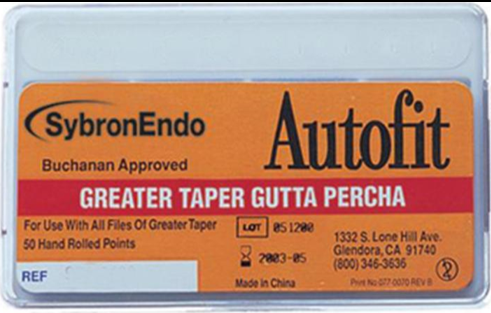
Medicated Gutta-Percha:
Calcium Hydroxide containing gutta-percha
They are made by combining 58% of calcium hydroxide in matrix of 42% gutta-percha. They are available in ISO size of 15-140. Presence of moisture in root canal enhances the action of Ca(OH)2
Advantages
Ease of insertion and removal
Minimal or no residue left
Firm for easy insertion
Disadvantages:
Short lived action
Radiolucent
Lack of sustained release
Iodoform containing gutta-percha
Iodoform containing gutta-percha remains inert till it comes in contact with the tissue fluids. Free iodine gets released in contact with tissue fluids giving an antibacterial property.
Gutta percha with chlorhexidine diacetate
5% chlorhexidine diacetate is embodied into the gutta percha matrix. This material is used as an intracanal medicament.
Coated cones
Available in two versions
Ultradent - have gutta percha surface coated with a resin, bond is formed when resin sealer comes in contact with resin coated gutta-percha cone. This inhibits leakage between the solid core and sealer. Use of EndoRez sealer is advocated.
Active GP Plus - with coating of glass ionomer on gutta-percha, designed for use with their glass ionomer sealer.
Resilon
Resilon became popular as a material substituting guttapercha to be used with a resin sealer like Epiphany to achieve an adhesive bond at three interfaces, the core material, the canal wall and the sealer. This technique creates a monoblock with a bond to canal wall on one side and a bond to the core material on the other. Resilon contains polymers of polyesters, bioactive glass and fillers like barium sulphate. It has similar handling properties as that of guttapercha, can be softened with heat or dissolved with solvents like chloroform. [4], [10] Resilon is a nontoxic, non-mutagenic, and biocompatible material. [4], [11], [12]
Pro points
Also known as “Smart sealing” system consisting of a nylon polymer core and a hydrophilic polymer coating. Can be used with a hydrophilic MTA based sealer in contact which the points go through hygroscopic expansion within the canal to fill voids. [1]
Obturation Techniques
Several obturation techniques exist with little difference in their long term outcome results and there is no technique that prevents leakage. [1], [13], [14] There is some evidence to suggest that warm vertical compaction is superior to lateral compaction. [1], [15], [16]
Classification of Root Canal Obturation Techniques:
According to the mode of practical use, the obturation techniques are classified as. [17], [18]
Single cone technique
Multiple-cone technique
Chemo-plasticized gutta-percha
Thermo-plasticized injectable gutta-percha obturation
Paste-only root fillings
SPAD/resorcinol formaldehyde
Single cone technique
In this technique, a greater taper cone of specific size fits exactly to the prepared canal. Such an approach is often used in conjunction with specific filing systems. This technique depends on the sealer and a three dimensional seal might not be achieved. Nonetheless, the apical portion should be well fitting. The Active GP precision obturation system utilizes Glass ionomer technology, extending the working time of the Glass ionomer sealer by modifying its particle size to the nanoparticle level. The gutta-percha cones are coated with Glass ionomer particles at a thickness of 2μm. The accuracy of the size of canal preparation to the size of cone to be used is very important to minimize the amount of sealer used and any chances of shrinkage as well. [19] Up to 49% of dentists favour this technique and laboratory evidence suggests that this is comparable to lateral compaction [1] ([Figure 2])
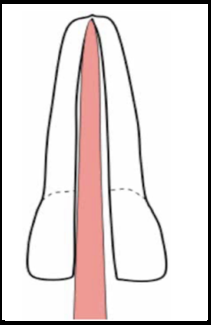
Cold lateral compaction
Use of a master cone which corresponds to the size of final canal preparation, smeared with sealer and placed into the canal. Additional accessory cones are compacted laterally to the master cone with the help of spreaders. [1] [Figure 5]
Advantages
Overfilling can be avoided and can be easily done in all kinds of root canal morphology.
Disadvantages
Gaps can exist if not compacted well and may not produce a homogeneous obturation.

Variations of Lateral Compaction Technique
Curved canals
NiTi spreaders are used. For severely curved canals, thermoplasticized gutta percha technique is preferred.
Blunderbuss canals
Also called open apex with no apical stop present, thus requires a process of apexification to close the apex. Customised gutta percha cone is prepared by joining multiple gutta percha cones from butt to tip until it can be rolled into one single cone softening with the help of ethyl chloride spray ([Figure 4]). For use in the canal, the outer surface of tailor made cone is dipped in chloroform, eucalyptol or halothane and then cone is placed in the canal. [4]
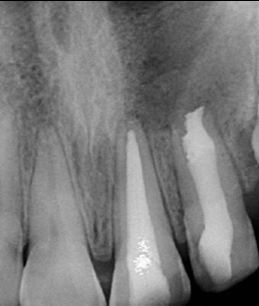
Warm Lateral
Use of a master cone which corresponds to the size of final canal preparation, smeared with sealer, placed into the canal and warm spreaders used for lateral compaction of the accessory cones. Some devices use vibration in addition to the warm spreader.[4], [20]
Warm vertical compaction
Use of a master cone which corresponds to the size of final canal preparation. The cone should resist displacement at this length. Then cone is coated with sealer, placed in the canal and compacted vertically using a heated plugger until the apical 3−4 mm segment of the canal is filled. Pre heated molten form of gutta percha is used to backfill the remaining canal space.[1]
Advantage
Excellent sealing of canal apically, laterally and accessory canals.
Disadvantages
Vertical root fracture, overfilling and time consuming.

There are alternative heating and obturating devices apart from using a flame heated instrument like “System B” and “Touch n heat” device which permit temperature control. They are to be used carefully as root surface heat generated greater than 10ºC can produce irreversible bone damage.
System B/Continuous Wave
It was developed by Buchanan to help warm the gutta percha in the canal. It monitors the tip temperature of the heat carrier pluggers and thus delivers a specific amount of heat. To achieve a good three dimensional obturation using system B, the canal should have an adequate taper and the set temperature should be such that it does not burn the gutta percha.
Advantages
It ensures proper condensation into main and lateral canals with excellent apical control. It creates single wave of heating and compacting thereby compaction of filling material can be done at the same time when it is heat softened.
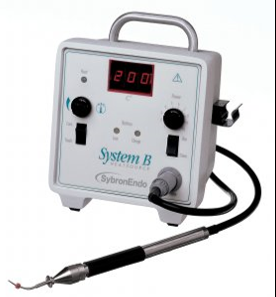
The Down Pak - 3D Obturation with heat and vibration
The Down Pak is an innovative device introduced to allow three dimensional obturation with heat and vibration. It has a vibrating spreader device that can be used for gutta percha, resilon & hybrid resin filling material by both warm vertical and lateral condensation techniques. Down Pak offers a wide selection of tips in NiTi and ultrasoft stainless steel. It ensures a denser and more compact filling of root canal space.
Lateral/Vertical compaction of warm gutta percha technique
Lateral compaction controls length of obturation while vertical compaction gives a three dimensional obturation. Endotec II combines advantages of both these techniques. It comes with a battery which provides energy to heat the attached plugger and spreader. [4] Endotec produces a fusion of the gutta-percha into a solid homogenous mass. This device’s technique requires cleaning and shaping of canals with a continuous taper design and an apical stop. [19]
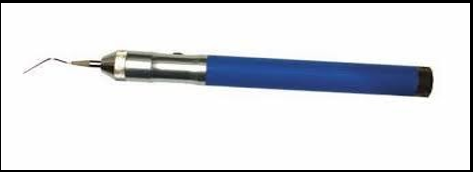
Sectional Method
Also known as Chicago technique. This technique involves the use of small pieces of gutta-percha cones to fill the sections of the canal.
Technique: GP cone of same size is selected and cut into sections (3 to 4 mm). A plugger loosely fitting within 3 mm of W.L is selected. Sealer is applied. One end of GP is mounted to heated plugger & carried into the canal and apical pressure is given and the plugger is disengaged by rotating it. A radiograph is taken to confirm its fit. If found satisfactory, the remaining canal in filled in same way.
Advantage
Ideal in cases of post core where only apical portion of canal is to be filled.
Disadvantage
Time consuming and difficult to remove the sections of gutta percha if there is overfilling.[4]
Thermo-mechanical compaction (McSpadden Compactor)
Mac-spadden compactor is used which resembles a reverse H-file. A cone coated with sealer is placed in the root canal, engaged with a rotary instrument (running between 5,000 and 10,000 rpm) that frictionally warms, plasticizes and compacts it into the root canal.[1] ([Figure 8])
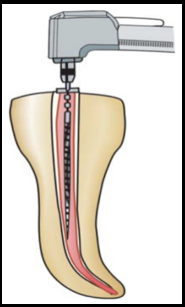
Advantages
It requires less chair side time, dense three dimensional obturation is achieved.
Disadvantages
Its difficult to use in narrow and curved canals because of frequent breakage of compactor blades. Overfilling of canals is also seen with this technique.
Thermo Plasticized GP injection techniques
The heating of gutta percha outside the tooth and injecting the material into the canal is the highlight of this technique. The clinician should take care of any extrusions. (1) Obtura II & III, Calamus, Elements, Hotshot and Ultrafil 3D are based on this concept.
A. Obtura II (Obtura Spartan, Earth City, Mo.): Introduced at Harvard Institute in 1977. It consists of an electric control unit with pistol grip syringe and specially designed gutta-percha pellets which are heated to approximately 365 – 3900 F(185-2000℃) for obturation. Root canal space has to be prepared well giving a smooth continuous taper. Obtura II is indicated in roots with straight or slightly curved canals and also used in cases of obturation of roots with internal resorption or perforations. [4]
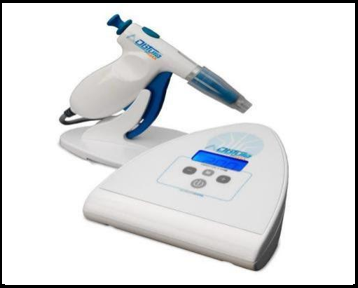
B. The Calamus Flow Obturation Delivery System: (Dentsply-Tulsa Dental. Tulsa, OK): Has a handpiece and activation cuff to enable control of the flow and temperature of the gutta-percha in to the canal. The activation cuff is released to stop the flow. It uses disposable single use catridges with a filling material indicator. The temperature of the thermoplasticized gutta-percha as it is extruded through the needle tip ranges from 38 o C to 44 o C. The gutta-percha remains able to flow for 45 to 60 seconds, depending on the viscosity.[19] ([Figure 11])
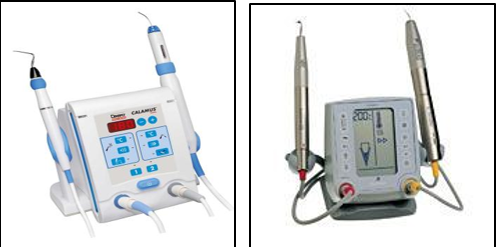
C. The Elements Obturation Unit (Sybron Endo): It contains a system B device and a gutta-percha extruder in a motorized handpiece. The extruder tips are sized 20, 23 & 25 gauge and are pre-bent. The disposable cartridges of gutta-percha are heated quickly and the unit shuts off automatically to prevent overheating of the material.[19]
D. The Ultrafill 3D System (Hygienic- Coltene- Whaledent): It is low heat (70℃) system with sterilizable injection syringe, three different types of disposable gutta-percha cannula with needles attached that can be pre-curved and a portable heating unit. Moisture or temperature does not affect its setting or solubility. The material expands slightly (0.2%) resulting in an excellent seal of the root canal. [19] ([Figure 11])
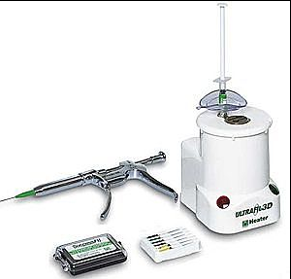
Apical Third Filling
Classification-
Carrier based: Simplifill obturator, Fiberfill obturator
Paste based system: Dentin chip filling, Calcium hydroxide, MTA
Carrier Based Gutta-Percha: [19]
Thermafil (Dentsply - Tulsa Dental)
Alpha form of guttapercha is coated on a plastic core and temperature is controlled by a heating device. A clinician has a time of approximately 10 seconds after heating to place it into the canal without rotating or twisting it. The carrier is resected after leaving it for 2-4 minutes for the GP to cool off.
Advantage
Effective sealing of lateral and accessory canals
Disadvantage
Occasional extrusion of materials beyond apex ([Figure 12])
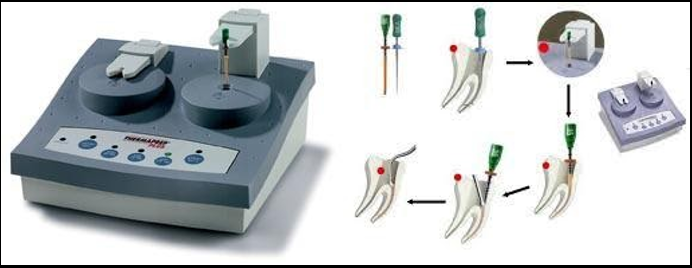
Successfil (Hygienic-Coltene Whaledent)
In this system guttapercha is available in syringe and carriers (Titanium or Radiopaque plastic) are inserted in to the syringe to a measured length of the canal. The rate of withdrawl from the syringe determines the amount and shape of guttapercha. The gutta-percha can be compacted around the carrier with various pluggers, depending on canal morphology. This is followed by the severing of the carrier slightly above the orifice using a bur.([Figure 13])

SimpliFill (Discus Dental, Culver City, CA)
It is employed following canal preparation using Lightspeed instruments. Here there is 5mm of guttapercha as an apical plug to the carrier. After canal preparation, the carrier is advanced within 1mm of the canal length prepared, pushed to the determined length using digital pressure and the carrier is then severed rotating the handle counter clockwise atleast four times. The coronal space can then be filled with gutta-percha. This sectional technique is efficient.([Figure 13])
Paste Based System
Dentin chip filling
It is also known as BIOLOGICAL SEAL. Here circumferential filing using H - file produces dentin debris which using butt end of a paper point is packed into the canal.[4]
Advantage
Biocompatible and minimal chances of extrusion
Disadvantage
Infected pulp tissue may get packed at the apex with the dentinal mass.
Calcium Hydroxide
Also known as apical barrier. Moist calcium hydroxide is placed in the canal with the help of a plugger and amalgam carrier, injectable syringes or by lentulospirals. Dry form of Ca(OH)2 is carried into the canal by an amalgam carrier which is then packed with pluggers. Calcium hydroxide is biocompatible and stimulates cementogenesis, thus used in apexification procedure as an apical barrier. [4]
Mineral Trioxide Aggregate
Developed by Dr. Torabinejad in 1993. Composed of tricalcium silicate, tricalcium aluminate, tetracalcium aluminoferrite with bismuth oxide. It is hydrophilic and sets in moist atmosphere. Adavantages: excellent biocompatibility, reduced toxicity, radio-opacity, bacteriostatic nature and resistance to marginal leakage. [4] ([Figure 14])
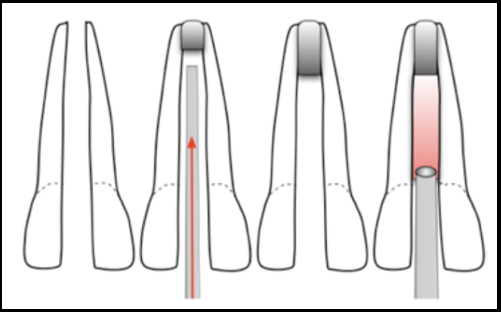
Cold Gutta Percha Compaction Technique [4]
Gutta Flow (Coltene Whaledent)
Consists of powdered guttapercha, silicon oil, paraffin oil, platinum dioxide and nano silver in a matrix of polydimethyl siloxane. It does require to be heated or compacted. ([Figure 15])
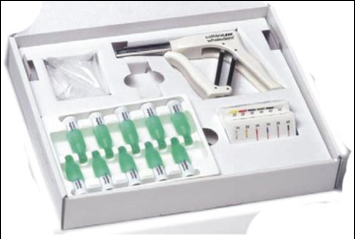
Chemoplasticized
Solvents like Chloroform or eucalyptol are employed to soften gutta percha already placed into the canals, lateral compaction done using spreaders and additional accessory cones used to fill empty spaces.
Silver cones
Ideally used for teeth with curved and tortuous canals or calcified canals. Its disadvantage is that it’s difficult to retrieve and prone to corrosion.
Conclusion
To achieve a successful endodontic therapy, it is crucial that all canals are located, cleaned & shaped, disinfected & sealed properly, not only in the apical portion but as well as coronal part of the root canal. Clinician should choose the obturating material & technique depending on the skills, experience and the situation of the root canal morphology and be remembered throughout the patient’s life through his competent work done on the patient’s tooth.
Source of Funding
No financial support was received for the work within this manuscript.
Conflict of Interests
The author declares that they do not have any conflict of interests.
References
- Darcey J, Roudsari R, Jawad S, Taylor C, Hunter M. Modern endodontic principles part 5: obturation. Dent Update. 2016;43(2):114-29. [Google Scholar] [Crossref]
- Wu M, Fan B, Wesselink P. Leakage Along Apical Root Fillings in Curved Root Canals. Part I: Effects of Apical Transportation on Seal of Root Fillings. J Endod . 2000;26(4):210-6. [Google Scholar] [Crossref]
- Tay F, Pashley D. Monoblocks in Root Canals: A Hypothetical or a Tangible Goal. J Endod . 2007;33(4):391-8. [Google Scholar] [Crossref]
- Deshpande PM, Naik RR. Comprehensive review on recent root canal filling materials and techniques-An update. Int J Appl Dent Sci. 2015;1:30-4. [Google Scholar]
- Hargreaves KM, Berman LH. Cohen's pathways of the pulp expert consult. . 2015. [Google Scholar]
- Bansode PV, Pathak SD, Wavdhane MB, Kale D. Obturating materials present and past: A review. J Dent Med Sci. 2018;17:27-33. [Google Scholar]
- Grossman LI, Oliet S, EC. Endodontic practice. 11th Edn.. 1988. [Google Scholar]
- RP, VG, DK. Assessment of the efficacy of an indigeniously developed pulse oximeter dental sensor holder for pulp vitality testing.. Indian J Dent Res. 2006;17(3). [Google Scholar] [Crossref]
- Nguyen TN. Obturation of the root canal system. Pathways Pulp. 1994;6:219-71. [Google Scholar]
- Resilon L. A comprehensive literature review. JODDD. 2013;7(3):119-31. [Google Scholar]
- Oliet S, Sorin S. Effect of aging on the mechanical properties of hand-rolled gutta-percha endodontic cones. Oral Surg, Oral Med, Oral Pathol. 1977;43:954-62. [Google Scholar] [Crossref]
- Shipper G, Ørstavik D, Teixeira F, MT. An Evaluation of Microbial Leakage in Roots Filled with a Thermoplastic Synthetic Polymer-Based Root Canal Filling Material (Resilon). J Endodon. 2004;30(5):342-7. [Google Scholar] [Crossref]
- Aqrabawi J. Outcome of Endodontic Treatment of Teeth Filled Using Lateral Condensation versus Vertical Compaction (Schilder's Technique). J Contemp Dent Pract . 2006;7(1):17-24. [Google Scholar] [Crossref]
- Ng Y, Mann V, Rahbaran S, Lewsey J, Gulabivala K. Outcome of primary root canal treatment: systematic review of the literature – Part 1. Effects of study characteristics on probability of success. Int Endod J . 2007;40(12):921-39. [Google Scholar] [Crossref]
- Chevigny C, Dao T, Basrani B, Marquis V, Farzaneh M, Abitbol S. Treatment Outcome in Endodontics: The Toronto Study—Phase 4: Initial Treatment. J Endod. 2008;34(3):258-63. [Google Scholar] [Crossref]
- Peng L, Ye L, Tan H, Zhou X. Outcome of Root Canal Obturation by Warm Gutta-Percha versus Cold Lateral Condensation: A Meta-analysis. J Endod . 2007;33(2):106-9. [Google Scholar] [Crossref]
- Lokhande PR, Ghorpade RR, Srinidhi SR. A review of contemporary research on root canal obturation and related quality assessment techniques. InInnovative Design, Analysis and Development Practices in Aerospace and Automotive Engineering (I-DAD 2018). . 2018. [Google Scholar]
- Jain S, Toit D, Montalli V. Contemporary Book on Root Canal Obturation. 1st Edn.. 2014. [Google Scholar]
- Kulkarni G. New Root Canal Obturation Technique. EC Dent Sci. 2017;11(2):68-76. [Google Scholar]
- Togger M. Evaluation of the apical seal produced by a hybrid root canal filling method, combining lateral condensation and thermatic compaction. JOE. 1984;10. [Google Scholar]
- Abstract
- Introduction
- Ideal Root Canal Filling Materials
- Types of Sealers
- Gutta Percha
- Medicated Gutta-Percha:
- Calcium Hydroxide containing gutta-percha
- Iodoform containing gutta-percha
- Gutta percha with chlorhexidine diacetate
- Coated cones
- Resilon
- Pro points
- Obturation Techniques
- Variations of Lateral Compaction Technique
- Curved canals
- Blunderbuss canals
- Warm Lateral
- Warm vertical compaction
- System B/Continuous Wave
- The Down Pak - 3D Obturation with heat and vibration
- Lateral/Vertical compaction of warm gutta percha technique
- Sectional Method
- Thermo-mechanical compaction (McSpadden Compactor)
- Thermo Plasticized GP injection techniques
- Apical Third Filling
- Carrier Based Gutta-Percha: [19]
- Thermafil (Dentsply - Tulsa Dental)
- Successfil (Hygienic-Coltene Whaledent)
- SimpliFill (Discus Dental, Culver City, CA)
- Paste Based System
- Calcium Hydroxide
- Mineral Trioxide Aggregate
- Cold Gutta Percha Compaction Technique [4]
- Conclusion
- Source of Funding
- Conflict of Interests
- References
How to Cite This Article
Vancouver
Soumya S, Agarwal P, Patri G, Behera SSP, Kumar M. Obturation an Overview [Internet]. IP Indian J Conserv Endod. 2021 [cited 2025 Oct 28];6(1):11-20. Available from: https://doi.org/10.18231/j.ijce.2021.004
APA
Soumya, S., Agarwal, P., Patri, G., Behera, S. S. P., Kumar, M. (2021). Obturation an Overview. IP Indian J Conserv Endod, 6(1), 11-20. https://doi.org/10.18231/j.ijce.2021.004
MLA
Soumya, Surabhi, Agarwal, Pratik, Patri, Gaurav, Behera, Sidhartha S P, Kumar, Madhurendra. "Obturation an Overview." IP Indian J Conserv Endod, vol. 6, no. 1, 2021, pp. 11-20. https://doi.org/10.18231/j.ijce.2021.004
Chicago
Soumya, S., Agarwal, P., Patri, G., Behera, S. S. P., Kumar, M.. "Obturation an Overview." IP Indian J Conserv Endod 6, no. 1 (2021): 11-20. https://doi.org/10.18231/j.ijce.2021.004
